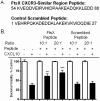CXCL10 Acts as a Bifunctional Antimicrobial Molecule against Bacillus anthracis
- PMID: 27165799
- PMCID: PMC4959661
- DOI: 10.1128/mBio.00334-16
CXCL10 Acts as a Bifunctional Antimicrobial Molecule against Bacillus anthracis
Abstract
Bacillus anthracis is killed by the interferon-inducible, ELR(-) CXC chemokine CXCL10. Previous studies showed that disruption of the gene encoding FtsX, a conserved membrane component of the ATP-binding cassette transporter-like complex FtsE/X, resulted in resistance to CXCL10. FtsX exhibits some sequence similarity to the mammalian CXCL10 receptor, CXCR3, suggesting that the CXCL10 N-terminal region that interacts with CXCR3 may also interact with FtsX. A C-terminal truncated CXCL10 was tested to determine if the FtsX-dependent antimicrobial activity is associated with the CXCR3-interacting N terminus. The truncated CXCL10 exhibited antimicrobial activity against the B. anthracis parent strain but not the ΔftsX mutant, which supports a key role for the CXCL10 N terminus. Mutations in FtsE, the conserved ATP-binding protein of the FtsE/X complex, resulted in resistance to both CXCL10 and truncated CXCL10, indicating that both FtsX and FtsE are important. Higher concentrations of CXCL10 overcame the resistance of the ΔftsX mutant to CXCL10, suggesting an FtsX-independent killing mechanism, likely involving its C-terminal α-helix, which resembles a cationic antimicrobial peptide. Membrane depolarization studies revealed that CXCL10 disrupted membranes of the B. anthracis parent strain and the ΔftsX mutant, but only the parent strain underwent depolarization with truncated CXCL10. These findings suggest that CXCL10 is a bifunctional molecule that kills B. anthracis by two mechanisms. FtsE/X-dependent killing is mediated through an N-terminal portion of CXCL10 and is not reliant upon the C-terminal α-helix. The FtsE/X-independent mechanism involves membrane depolarization by CXCL10, likely because of its α-helix. These findings present a new paradigm for understanding mechanisms by which CXCL10 and related chemokines kill bacteria.
Importance: Chemokines are a class of molecules known for their chemoattractant properties but more recently have been shown to possess antimicrobial activity against a wide range of Gram-positive and Gram-negative bacterial pathogens. The mechanism(s) by which these chemokines kill bacteria is not well understood, but it is generally thought to be due to the conserved amphipathic C-terminal α-helix that resembles cationic antimicrobial peptides in charge and secondary structure. Our present study indicates that the interferon-inducible, ELR(-) chemokine CXCL10 kills the Gram-positive pathogen Bacillus anthracis through multiple molecular mechanisms. One mechanism is mediated by interaction of CXCL10 with the bacterial FtsE/X complex and does not require the presence of the CXCL10 C-terminal α-helix. The second mechanism is FtsE/X receptor independent and kills through membrane disruption due to the C-terminal α-helix. This study represents a new paradigm for understanding how chemokines exert an antimicrobial effect that may prove applicable to other bacterial species.
Copyright © 2016 Margulieux et al.
Figures






Similar articles
-
Identification of the bacterial protein FtsX as a unique target of chemokine-mediated antimicrobial activity against Bacillus anthracis.Proc Natl Acad Sci U S A. 2011 Oct 11;108(41):17159-64. doi: 10.1073/pnas.1108495108. Epub 2011 Sep 26. Proc Natl Acad Sci U S A. 2011. PMID: 21949405 Free PMC article.
-
Bacillus anthracis Peptidoglycan Integrity Is Disrupted by the Chemokine CXCL10 through the FtsE/X Complex.Front Microbiol. 2017 Apr 27;8:740. doi: 10.3389/fmicb.2017.00740. eCollection 2017. Front Microbiol. 2017. PMID: 28496437 Free PMC article.
-
The Opp (AmiACDEF) Oligopeptide Transporter Mediates Resistance of Serotype 2 Streptococcus pneumoniae D39 to Killing by Chemokine CXCL10 and Other Antimicrobial Peptides.J Bacteriol. 2018 May 9;200(11):e00745-17. doi: 10.1128/JB.00745-17. Print 2018 Jun 1. J Bacteriol. 2018. PMID: 29581408 Free PMC article.
-
Chemokine (C-X-C motif) ligand (CXCL)10 in autoimmune diseases.Autoimmun Rev. 2014 Mar;13(3):272-80. doi: 10.1016/j.autrev.2013.10.010. Epub 2013 Nov 2. Autoimmun Rev. 2014. PMID: 24189283 Review.
-
The multifaceted functions of CXCL10 in cardiovascular disease.Biomed Res Int. 2014;2014:893106. doi: 10.1155/2014/893106. Epub 2014 Apr 23. Biomed Res Int. 2014. PMID: 24868552 Free PMC article. Review.
Cited by
-
Lung epithelial cells: therapeutically inducible effectors of antimicrobial defense.Mucosal Immunol. 2018 Jan;11(1):21-34. doi: 10.1038/mi.2017.71. Epub 2017 Aug 16. Mucosal Immunol. 2018. PMID: 28812547 Free PMC article. Review.
-
The commensal skin microbiota triggers type I IFN-dependent innate repair responses in injured skin.Nat Immunol. 2020 Sep;21(9):1034-1045. doi: 10.1038/s41590-020-0721-6. Epub 2020 Jul 13. Nat Immunol. 2020. PMID: 32661363
-
Differential Gene Expression Induced by Different TLR Agonists in A549 Lung Epithelial Cells Is Modulated by CRISPR Activation of TLR10.Biomolecules. 2022 Dec 22;13(1):19. doi: 10.3390/biom13010019. Biomolecules. 2022. PMID: 36671404 Free PMC article.
-
A Teleost CXCL10 Is Both an Immunoregulator and an Antimicrobial.Front Immunol. 2022 Jun 20;13:917697. doi: 10.3389/fimmu.2022.917697. eCollection 2022. Front Immunol. 2022. PMID: 35795684 Free PMC article.
-
The interferon stimulated gene viperin, restricts Shigella. flexneri in vitro.Sci Rep. 2019 Oct 30;9(1):15598. doi: 10.1038/s41598-019-52130-8. Sci Rep. 2019. PMID: 31666594 Free PMC article.
References
-
- Mortality and Causes of Death Collaborators 2015. Global, regional, and national age-sex specific all-cause and cause-specific mortality for 240 causes of death, 1990–2013: a systematic analysis for the Global Burden of Disease Study 2013. Lancet 385:117–171. doi:10.1016/S0140-6736(14)61682-2. - DOI - PMC - PubMed
Publication types
MeSH terms
Substances
Grants and funding
LinkOut - more resources
Full Text Sources
Other Literature Sources
Medical
